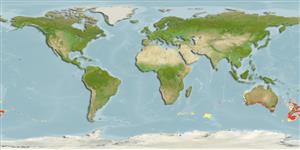Environment: milieu / climate zone / depth range / distribution range
Ecology
Marine; demersal; depth range 120 - 900 m (Ref. 33839). Temperate
Indo-West Pacific: southern Australia to New South Wales and Tasmania.
Size / Weight / Age
Maturity: Lm ? range ? - ? cm
Max length : 20.0 cm TL male/unsexed; (Ref. 9563)
Short description
Identification keys | Morphology | Morphometrics
Dorsal soft rays (total): 104 - 115; Anal soft rays: 84 - 92. Body moderately deep (38-44% SL). Snout not produced. Mouth oblique. Scales very small, rather firmly attached; ctenoid on both sides, covering all of head, including adjoining portions of eyes. Pelvic fin rays on right side 10-11, left 5-6. Caudal fin rays 14-16 (Ref. 33839).
Life cycle and mating behavior
Maturities | Reproduction | Spawnings | Egg(s) | Fecundities | Larvae
May, J.L. and J.G.H. Maxwell, 1986. Trawl fish from temperate waters of Australia. CSIRO Division of Fisheries Research, Tasmania. 492 p. (Ref. 9563)
IUCN Red List Status (Ref. 130435)
Threat to humans
Harmless
Human uses
Tools
Special reports
Download XML
Internet sources
Estimates based on models
Preferred temperature (Ref.
123201): 6.9 - 13.3, mean 10 °C (based on 123 cells).
Phylogenetic diversity index (Ref.
82804): PD
50 = 1.0000 [Uniqueness, from 0.5 = low to 2.0 = high].
Bayesian length-weight: a=0.01820 (0.00786 - 0.04213), b=2.97 (2.76 - 3.18), in cm total length, based on LWR estimates for this (Sub)family-body shape (Ref.
93245).
Trophic level (Ref.
69278): 3.1 ±0.2 se; based on size and trophs of closest relatives
Resilience (Ref.
120179): High, minimum population doubling time less than 15 months (Preliminary K or Fecundity.).
Fishing Vulnerability (Ref.
59153): Low vulnerability (10 of 100).
